Science
Frogs and Toads Together: Why do Amphibians Group Up?April 11, 2025


Groundhog Day is coming up and can be a wonderful opportunity to fulfill some of your curricular goals in reading, writing, and science. Activities for Groundhog Day can come in all different themes including shadows, animal needs, seasons, and weather. Consider using a Groundhog Day book to introduce the holiday to your students and to base your activities for Groundhog Day on. This article uses the book Groundhog Weather School by Joan Holub as inspiration for 16 activities for Groundhog Day, but most of the activities could stand alone or be paired with a different Groundhog Day book.
If you’re unfamiliar with the Groundhog Day book Groundhog Weather School by Joan Holub, you’re in for a treat! This humorous story starts off with a rabbit that is listening to the weather forecast of a groundhog to decide if he can go out sunbathing. It turns out that the groundhog’s prediction was wrong and the rabbit suggests that he recruits other groundhogs to help him tell the weather. Professor Groundhog puts an ad in the newspaper and accepts groundhogs into a weather school to learn their geHOGraphy, famous hognosticators, other nature weather predictors, background on hibernation, how seasons are made, and shadow studies.
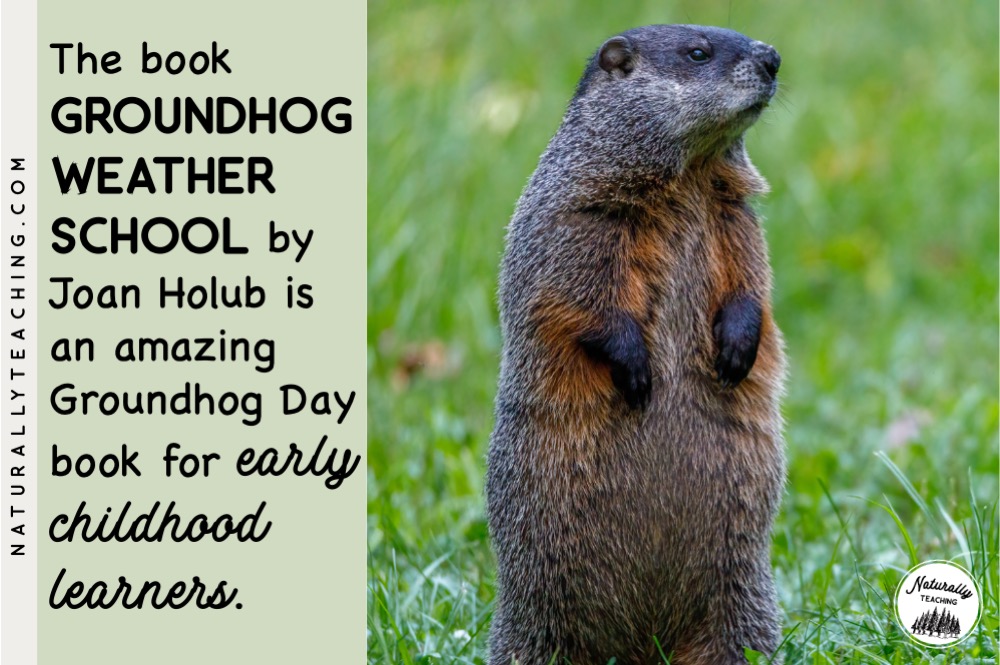
The author uses humor as well as facts to help educate your students about many different science topics. With the story being told through the context of school, your students will be able to relate to many of the illustrations and activities that the groundhogs experience throughout the story. The story ends with all of the graduates from Groundhog weather school sending in their reports on February 2nd and Professor Groundhog giving the agreed upon prediction.
The Groundhog Day book Groundhog Weather School lends itself to several different types of activities for Groundhog Day. There are many wonderful ways you can celebrate this story through reading, writing, science, and craft activities. Read on to discover activities paired with the Headstart Early Learning Outcomes Framework for Preschool and ELA Common Core State Standards and Next Generation Science Standards for grades Kindergarten through 2nd grade.
Looking for activities for Groundhog Day for a specific grade? Click the links below to navigate further down the page to your desired level.
Groundhog Day is a fantastic opportunity to get your preschoolers interested in weather. Weather is an inherently fascinating phenomenon, especially for preschoolers that are just becoming aware of their surroundings. If you’re not familiar with weather concepts and feel intimated about teaching it, check out my blog post “Answers to 7 FAQs to Help With Your Weather Teaching in Elementary School” for a breakdown of what makes weather, what are the different types of weather, and more.
Included in this section, Groundhog Day preschool activities, are activities for literacy, scientific reasoning, and fine motor development inspired by the Groundhog Day book Groundhog Weather School and tied to the Headstart Early Learning Outcomes Framework.
Preschoolers work hard to develop ways to express themselves. One way to give your preschoolers a chance to share their understanding of weather is through journaling. After reading the Groundhog Day book Groundhog Weather School, provide your students with a weather journal. This can be as simple as a few pages of blank paper stapled together.
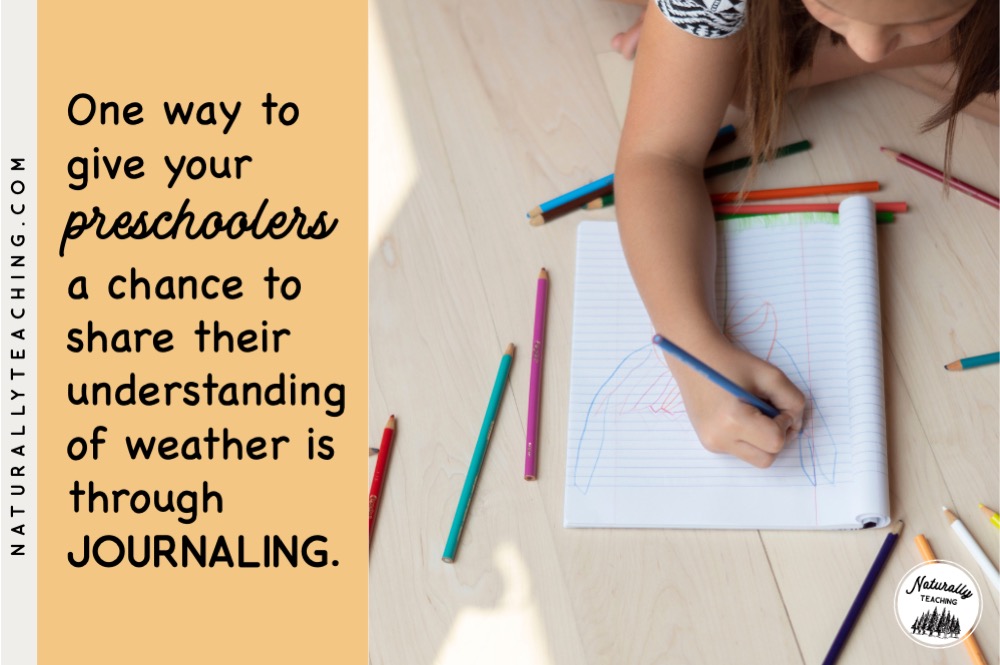
Grab a basket or bin of markers, crayons, or colored pencils, and go out into your schoolyard with clipboards and weather journals. Give your preschoolers time to journal about the weather they see outside. Most of your students will use pictures to express their understanding of what is happening with the weather, but encourage those with more writing skills to add symbols or words for more detail. Walk around and ask them questions about their journal entries, jotting down notes on their page. Try to do this a few times when the weather is different so that your students can start to become familiar with different types of weather.
Click here to jump to a related Groundhog Day craft for preschool!
Your preschoolers are very inquisitive and love exploring with their senses. Get outside and explore the weather with those five senses! It may take a little coaching at first, but your students will be able to find different elements of the weather based on their different senses. Have your students spread out in your schoolyard and start with what they see. Encourage them to tell someone close by what they see in the sky (e.g. clouds, the sun, rain, a rainbow, snow, etc). After sharing, have your students put a finger on their nose if they saw fill-in-the-blank (whatever you saw as the teacher while you were observing). By using the pair-share technique and finger voting, your students will get a chance to talk with someone while also getting a chance to share with you; most preschoolers want to be heard and this provides them that opportunity.
Move through the remainder of the senses from easiest-to-experience to hardest-to-experience. Have your students tell someone different what they heard that relates to the weather (e.g. wind in the trees, rain falling, etc). Ask the class if they experienced fill-in-the-blank and share by putting a finger on their nose. Have your students tell someone different what they felt that relates to weather (e.g. the sun, snow falling, wind, etc). Ask the class if they experienced fill-in-the-blank and share by putting a finger on their nose. Lastly, have the class tell someone new what they smelled that relates to weather (e.g. the smell of rain, the sun drying out bark, etc). Ask the class if they experienced fill-in-the-blank and share by putting a finger on their nose. They may not experience smell, and that’s okay.
Using the sense of taste outside can be dangerous, so you can either opt to skip that sense or you can provide your students with fun weather-themed snacks that you eat inside. You could ask for help from parents to provide you orange juice (a drink made from the power of the sun), cloud jello (blue jello layered with cool whip), clementines (looks like the sun but also was made from the power of the sun), rainbow cookies, snowballs, and more. Searching on Pinterest will bring you many wonderful possibilities to celebrate your students’ sense of taste!
If you feel like your students need less structure and more room to explore, you could skip the senses focus and complete a weather scavenger hunt. Add pictures of different types of weather onto a paper and give your students boundaries outside to explore. If you want to skip the prep, you can find my Weather Scavenger Hunt PDF here!
Give your students a chance to develop their fine motor skills by using weather collection tools. They will feel like scientists while also developing those small muscles. Some weather collection tools to try with your students include thermometers, anemometers (wind gauges), rulers, rain gauges, and cloud charts. You could also provide your students with magnifying glasses that they can use to look closely for nature’s weather predictors as pointed out in the story.
Feel like you don’t have the tools in your classroom? That’s a-okay, many of them are easy to make. You can search Pinterest for tutorials on making rain gauges and anemometers. Making a simple “wind gauge” is easy by creating a pinwheel or adhering lengths of yarn onto craft sticks. You can print off different cloud charts that the kids can use through the window in your classroom or while they’re outside. At this stage it is more about the exposure to scientific tools and the development of fine motor skills than the accuracy of data collection.
Click here to jump to a Groundhog Day craft for preschool!
Kindergarteners are at a prime stage to celebrate Groundhog Day! This day is filled with wonder and excitement and can be a great hook to get your kindergarteners invested in the topic of weather. The kindergarten Groundhog Day activities section includes an activity idea for reading, writing, and science. Reading, writing, and science are inexplicably linked, and when you integrate them together in your own classroom, can help you save time in your very busy schedule.
Read aloud the Groundhog Day book Groundhog Weather School and ask your students to keep an eye and an ear out for words they don’t recognize. When they hear an unknown word they can raise their hand to share it with the rest of the class. You can choose to make a list of the words they share and then come back to them at the end of the story or you can try to use the context in the sentence to decode what the word means, either way can be effective.
Here is a list of words from Groundhog Weather School that your kindergarten students may run into trouble with, including child-friendly definitions:
If you choose to decode while reading the book, this technique can help to develop your students’ abilities to use surrounding words and other textual clues to decide an appropriate definition for the word. They can also use clues from the illustrations to help them determine what the words mean. If you choose to make a list and address the words at the end of the book you could use this as an opportunity to try dictionaries to look up unknown words.
After reading the Groundhog Day book Groundhog Weather School, ask your students a question about an opinion they formed while listening to the book. Some ideas for questions include, “Do you think that predicting the weather is difficult?” or “Do you think that Groundhogs make good weather forecasters?” It is important to remind your students that an opinion is something they think and isn’t right or wrong; it’s okay if their opinion is different than their neighbor. Remind them to use evidence from the story to support their opinion.
Now that your students are super pumped about weather, give them a shot at being weather forecasters! There are a couple of different ways to do this depending on how intense you want to get. A relaxed way to give your students a chance to forecast the weather is to provide them with a weather wheel. These printable tools are easy to assemble (they just take scissors, crayons, and brads) but are a lot of fun for your students to manipulate. If you don’t want to have to hunt down a quality weather wheel, follow this link to get my Free Printable Weather Wheel and Lesson Plan for Teachers!
A more involved way to get your kindergarteners weather forecasting is by having them put together their own weather forecast shows in partners or small groups. You can encourage your students to make props out of craft materials and dress up in fun weather forecasting outfits. You can provide your students background knowledge of what a weather forecast looks like by watching your local weather forecast or by watching the big reveal on Groundhog Day from the previous year. Give your students time to practice their forecast shows the day before Groundhog Day and then give them a chance to show off their hard work on the big day!
Click here to jump to a related Groundhog Day craft for kindergarten!
Groundhog Day was meant for your 1st graders that are studying light! There aren’t many opportunities to seamlessly intertwine holidays into your science studies, but theming your activities for Groundhog Day around sunlight and shadows will make this a connection your students will remember. Read this section all about 1st grade activities for Groundhog Day including reading and writing activities tied to the ELA Common Core State Standards and a science experiment tied to the Next Generation Science Standards.
This story has many different voices and can be an engaging way for your students to begin identifying who is speaking in a picture book. Some pages are designed similarly to comic books with speech bubbles coming from different speakers’ mouths. There are also written documents like the letter from the rabbit and the newspaper ad that Professor Groundhog puts together. Your students will get to practice using clues from the text and the illustrations to begin to identify who is telling the story at different points throughout the book (and they’ll love doing it!).
This Groundhog Day book, Groundhog Weather School, is full of facts! Facts about groundhogs, seasons, and light to name a few of the topics. After reading Groundhog Weather School, select a topic for your students to write an informative text about. If this is one of the first times that you are working on this sort of writing with your students, consider writing a topic sentence together as a class. After they have their topic sentence, project or hold up the pages of the book that coordinate to the topic that you have chosen. These pictures will act as a visual reminder of the facts and will help your students recall what support they want to use in their writing. Remind them to use at least two facts from the text to support their topic sentence. When everyone has written their two facts, work together as a class to write a concluding sentence.
Shadows are created when something moves into the path of a beam of light; exactly what the Next Generation Science Standards is asking 1st graders to study! Groundhog Day is all about whether or not the groundhog sees its shadow. We can also think about it as whether or not the groundhog moves into the path of a beam from the sun. This is where the Groundhog Day and 1st grade connection really shines (no pun intended).
Consider collecting a variety of recyclables from your home or ask for parents to collect *clean* recyclables to donate for your Groundhog Day experiment. Try to be intentional about collecting recyclables that are opaque, translucent, and transparent. After collecting recyclables, get your students ready for their Groundhog Day experiment the day before the holiday by bringing everyone to sit on the edge of your classroom rug. Spread the recyclables out in front of your students and talk about what happens when things get in the way of a beam of light. Open it up to your students and have a classroom discussion using agreed upon rules. If they are unsure, ask what happens when they are walking along the sidewalk on a sunny day; hopefully someone will say they see a shadow. Discuss what color their shadow is.
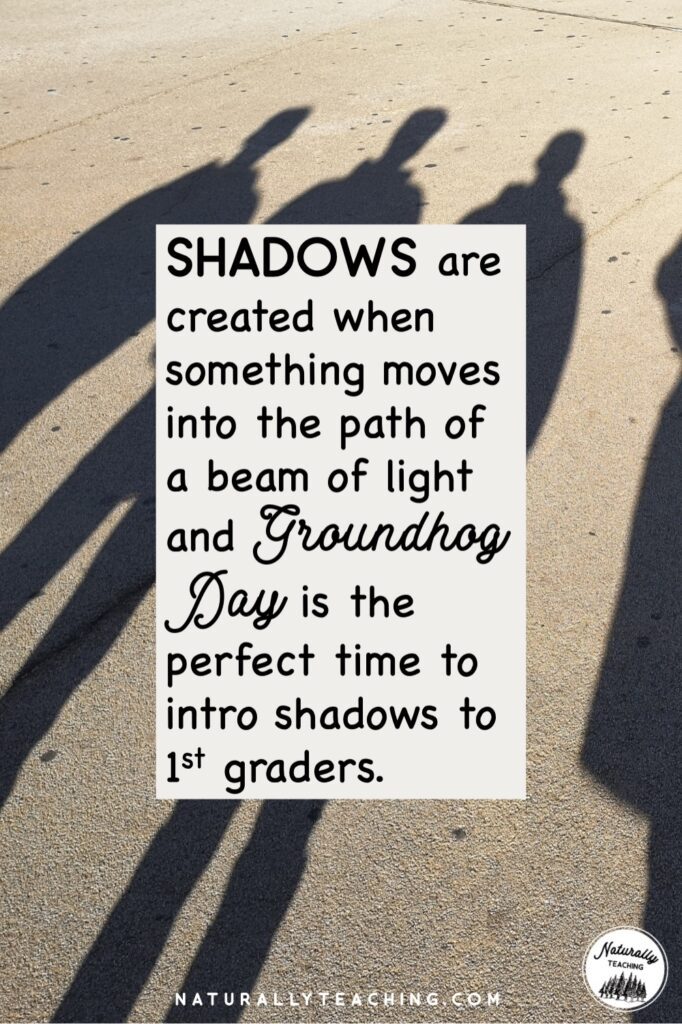
After talking about shadows for a little bit, start holding up recyclables one at a time and ask what they think would happen if the object was placed on the sidewalk on a sunny day. Someone will probably connect that there would be a shadow made. What color do they think the shadow will be? Hold up a variety of objects and discuss what they think would happen in the same scenario. If you are short on time try to hold up at least one object that is opaque, one that is translucent, and one that is transparent.
After they have been prepped and it is Groundhog Day, take a peek outside to see if you will have enough sunlight to run this experiment out on the sidewalk as you discussed in class. If there are too many clouds in the sky and you are unable to run this experiment outside, have on hand a secondary source of light. This could be a set of flashlights that the kids could use in groups, a lamp without a shade, or the lights in the hallway (if they are bright enough to create shadows).
Bring your recyclables to your light source along with pencils, crayons, paper, and clipboards. Before your students experiment with the different objects, have them diagram the object and write a hypothesis for what they think might happen when the object is placed in the path of a beam of light. Have them place the object in the path of the beam of light and record what happened in words and on their diagram. Opaque objects will have a dark gray or black shadow. Translucent objects will have a lighter shadow that will have a tint of color depending on what the material is made out of. And transparent objects will likely not have a shadow.
Click here to jump to related Groundhog Day craft ideas for 1st grade!
Although 2nd graders are at the tail end of early childhood, they are still able to engage with and get excited about activities for Groundhog Day. Second graders are in a unique point in their education that they have writing skills to be able to share their understanding but they still very much enjoy illustrating their point. This unique position can be helpful when planning your activities for Groundhog Day. This section about 2nd grade activities for Groundhog Day includes ideas tied to the ELA Common Core State Standards for reading and writing and the Next Generation Science Standards for science.
There are a variety of challenges in this Groundhog Day book, Groundhog Weather School. At the beginning, Rabbit found himself challenged by Professor Groundhog’s inaccurate forecast. Work with your students to look at the illustrations and the words to determine that Rabbit submitted a letter to Professor Groundhog to solve his problem for the following year.
Inspired by the request that Rabbit submitted, Professor Groundhog was challenged to find more animals to help him predict the weather all over North America. What did he do to solve that problem? He put an ad in the newspaper and started a Groundhog weather school to teach other groundhogs about weather forecasting.
Skunk read the newspaper ad and was disappointed that he didn’t check all of the boxes to be able to attend Groundhog weather school. He thought that a skunk could forecast the weather too. What did he do about it? He became a “foreign exchange student” at the groundhog weather school. He ended up graduating and forecasting the weather the next February 2nd.
Use this Groundhog Day book to get your students to start looking closely at a storyline for challenges and major events and how the characters react to those events. Ask your students how they think they would have handled the situations the characters were in. Do they think the characters handled their challenges well or should they have done something different?
Groundhog Day tends to be a well-celebrated holiday in elementary schools in the United States. Encourage your students to think back to a previous year’s Groundhog Day celebration or activity and write a narrative about their experience. Remind them to include details and temporal words to indicate the sequence of events in order to make their narrative a more interesting read. Give them the opportunity to illustrate their experience.
This Groundhog Day book Groundhog Weather School is packed full of interesting facts about groundhogs (aka woodchucks). Have your class complete a study on woodchucks and what they need from their habitat. The story itself introduces the range map of woodchucks in the United States as well as the types of predators they have to look out for, other animals that are related to them, what they eat, how they spend the winter, and more.
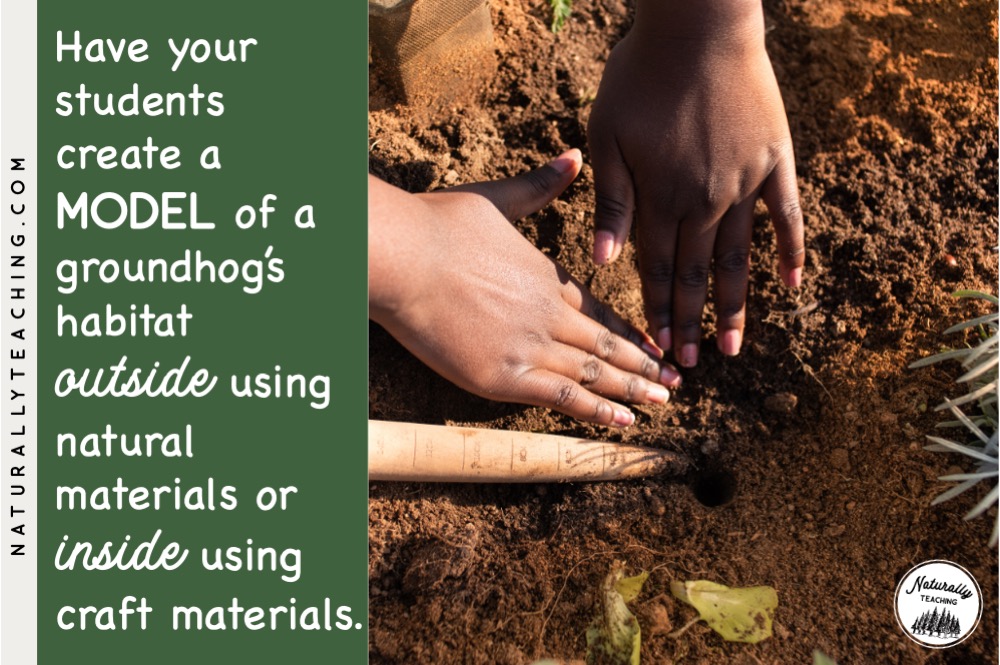
After learning more about woodchucks, have your students create a model of a groundhog’s habitat. You could do this outside using natural materials or inside using craft materials. If you choose to go outside and use natural materials, encourage your students to build miniature models and not life-sized ones. They should also use materials from nature that are already dead, down on the ground, and detached from other pieces of nature in order to minimize the potential for injuries. Once they’ve completed their models, you could either take a picture of each child’s model or you could have them bring out paper, clipboards, pencils, and coloring utensils to draw a diagram of their model.
If you choose to create models inside using craft materials, encourage your students to bring in a shoe box or a tissue box as the base of their habitat. Remind them that habitats include food, water, shelter, and space. These models could become very intricate and detailed, so make sure to give your 2nd graders plenty of time to create! In both instances you could allow your students to have a gallery walk to show off their hard work once everyone has completed their diagrams.
Click here to jump to related Groundhog Day craft activities for 2nd grade!
When teachers think about activities for Groundhog Day their minds often go to crafts. Keep reading for grade-specific crafts that coordinate with one of the activities listed previously in this article in an effort to keep your awesome Groundhog Day themes going!
Create a weather journal as a Groundhog Day craft for preschool. Suggested earlier in the Groundhog Day preschool activities section was the writing activity of a weather journal. Allowing your students to create their own weather journal will give them ownership of the journal which will create more engagement and excitement about its use. This task can also work on fine motor skills, depending on how you plan to put it together.
Materials you will need include blank paper, coloring utensils, and some form of binding. You could three hole punch the paper and use yarn for binding. Another option would be to bring out staplers and help your students staple the papers together. Alternatively, you could hole punch the upper left hand corner of the papers and use a binder clip to connect them together. Give your students a chance to decorate the front of their journal with coloring utensils and weather stickers if you have them.
Make weather forecasting props as a Groundhog Day craft for kindergarten. Suggested earlier in the Kindergarten Groundhog Day activities section was the science activity of allowing your students to become weather forecasters. Provide your students time to create props to help with their weather forecasting skits.
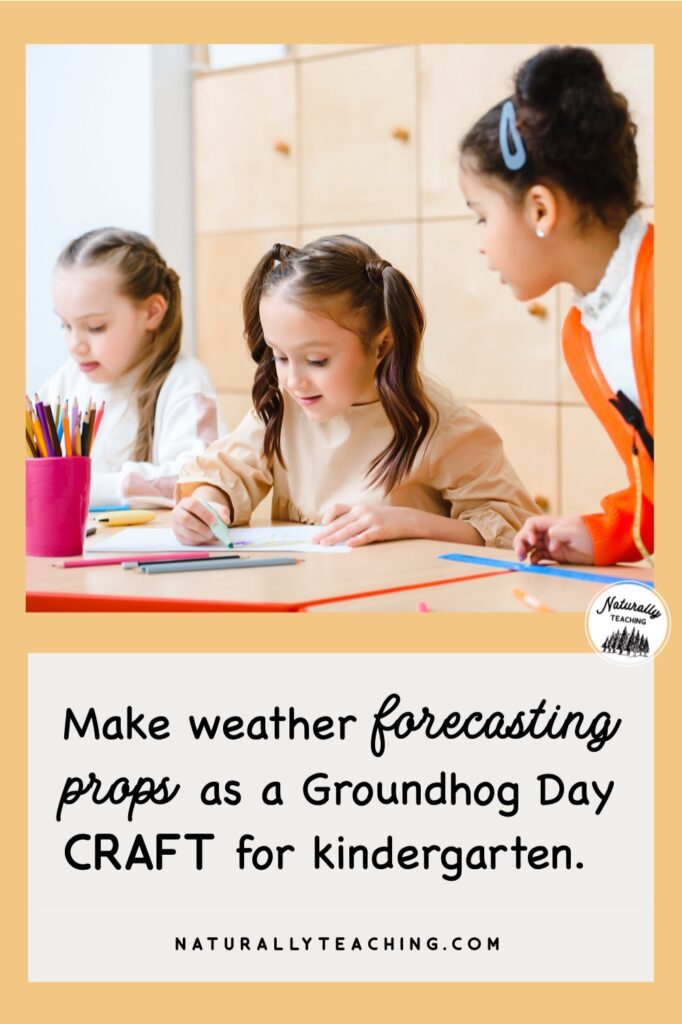
Materials you will need include construction paper, coloring utensils, craft sticks, glue, tape, and scissors. Give your students time to create signs with weather words and pictures of different types of weather to be used during their Groundhog Day weather forecasts.
Create different shadow art projects as Groundhog Day craft ideas for 1st grade. Earlier in this article in the 1st grade activities for Groundhog Day section the science was focused around shadows and how they are made. Give your students another experience creating shadows by completing one (or more) of these shadow art projects on Groundhog Day.
Make woodchucks and their predators out of self-hardening clay as Groundhog Day craft activities for 2nd grade. Suggested earlier in the 2nd grade activities for Groundhog Day section was the science activity of creating woodchuck habitat models. These models are kind of like crafts but serve a scientific purpose.
Giving your students a chunk of self-drying clay and having them create the animals that live within their model is a very fun craft indeed! Most children love using clay and they will enjoy getting the chance to populate their diagram with little creatures. This also gives you a chance to check their understanding of what animals live in the same habitats as woodchucks; a win-win!
Prep for this craft by cutting the clay with thick wire so that each child gets roughly the same amount of clay. You can store them in plastic bags or wrap them tightly with plastic wrap and then place them in an air-tight container or a large plastic bag. Make sure to have tablecloths, paper plates, or newspapers to cover your students’ workspaces; clay can get pretty messy pretty quickly. Providing your 2nd graders with toothpicks will allow them to add details to their animals. The animals will need to dry overnight. Once dry, they can be painted or colored with markers to add the finishing touches.
Hopefully this article all about activities for Groundhog Day gave you the inspiration you needed for your early childhood classroom. Whether you use one of these 16 activities for your students, modify one to meet your needs, or come up with one on your own, your students will benefit greatly from your time and effort. Remember that reading, writing, and science are inexplicably linked, and when you integrate them together in your own classroom, it can help save time in your very busy schedule!
If you’re studying weather with your students this year, don’t forget about the free Printable Weather Wheel and Lesson Plan for Teachers! Also, if you feel like you need more background information about weather, check out the article “Answers to 7 FAQs to Help With Your Weather Teaching in Elementary School.”
Do you have any amazing activities for Groundhog Day you enjoy doing with your class? Describe them in the comments section to help out a fellow early childhood teacher!
Check out this podcast episode for unique ways to teach with books!
One thought on “16 Activities for Groundhog Day Inspired by the Book “Groundhog Weather School””